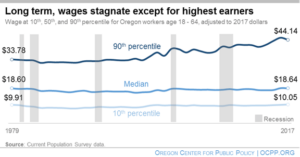Even though the paychecks of Oregon workers have grown recently, many workers have seen no real gains in their wages over the long haul, according to a new report published by the Oregon Center for Public Policy.
“The good news this Labor Day is that Oregon workers are enjoying a rebound in their wages,” said Center policy analyst Janet Bauer. “The disappointing news is that these gains are not enough to change the picture of stagnant wages over the long term.”
Some of Oregon’s lowest paid workers are seeing the biggest increases in their paychecks since wages began to tick up in the years following the Great Recession, the report found. For the worker at the 20th percentile (80 percent of workers make more; 20 percent make less), hourly wages rose about 12 percent between 2013 and 2017. That boost in wages was bigger than growth experienced by any other group of workers.
In part, the wage gains are the result of a growing Oregon economy. Employers are having to compete to attract workers, creating pressure on them to increase wages, Bauer said.
Another factor driving the wage gains, especially for lower wage workers, is the rising minimum wage, according to the report. The data analyzed by the Center reflected increases to the minimum wage that took effect in July 2016 and July 2017.
“We’re seeing once again that minimum wage increases can go hand-in-hand with a strong labor market,” Bauer said. “Oregon lawmakers did the right thing when they chose to meaningfully lift the wage floor in our state.”

Even accounting for the recent wage gains, many workers are experiencing no real progress over the long term, the Center reported. The median wage earner — the worker in the middle of the wage scale — made $18.64 an hour in 2017. That was just four cents more than the median wage earner made in 1979, when adjusted for inflation.
Workers at the top, however, have enjoyed substantial wage gains over the past four decades. The Center found that the hourly wage of the worker at the 90th percentile (paid more than 9 out of 10 workers) increased from $33.78 to $44.14 between 1979 and 2017 — an increase of more than 30 percent.
“Wages reflect the broader theme of our era, one of a growing divide between those at the top and the rest,” said Bauer. “It’s a structural problem in our economy, and it is certainly one that can be addressed with the right public policies.”








